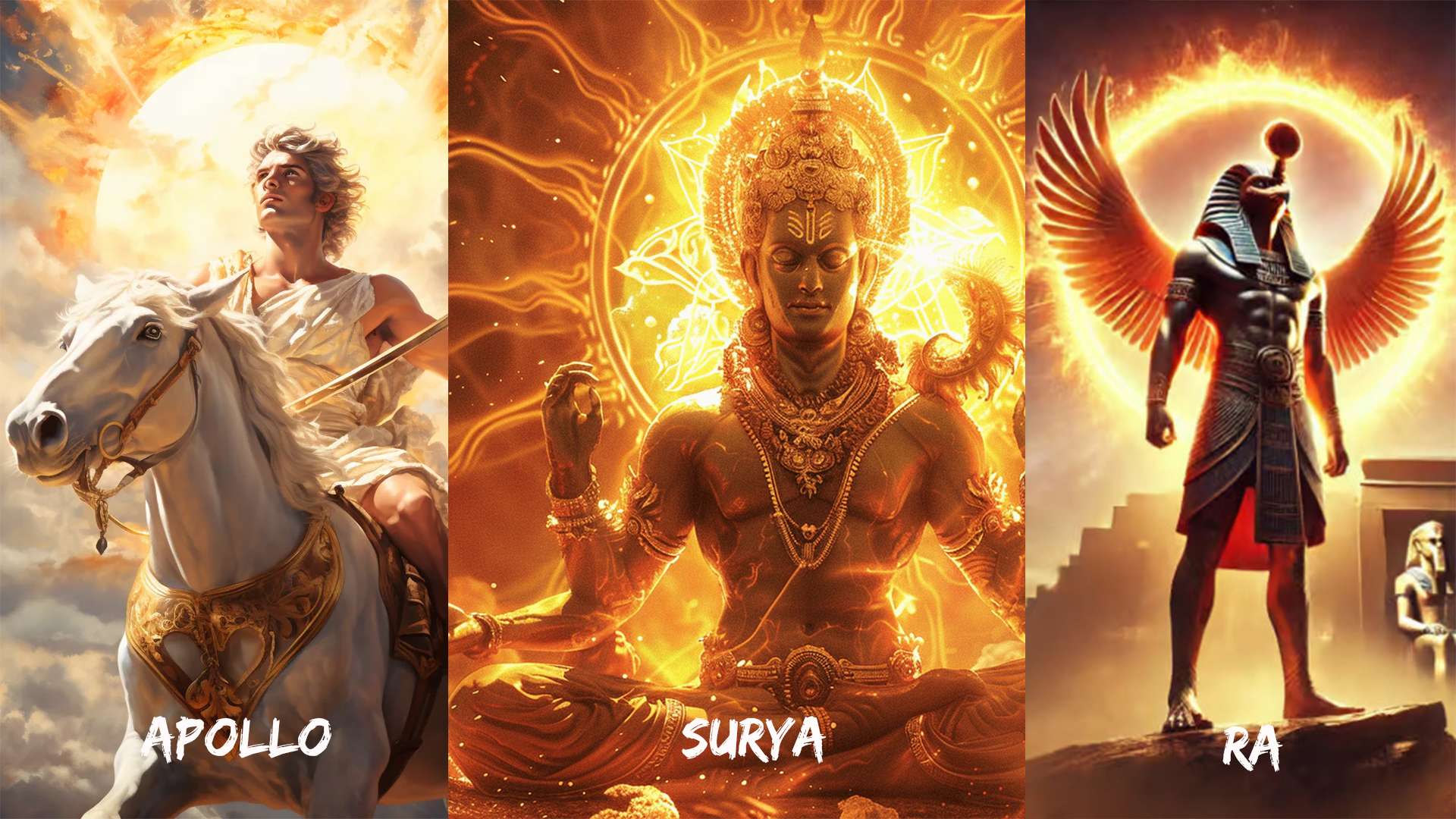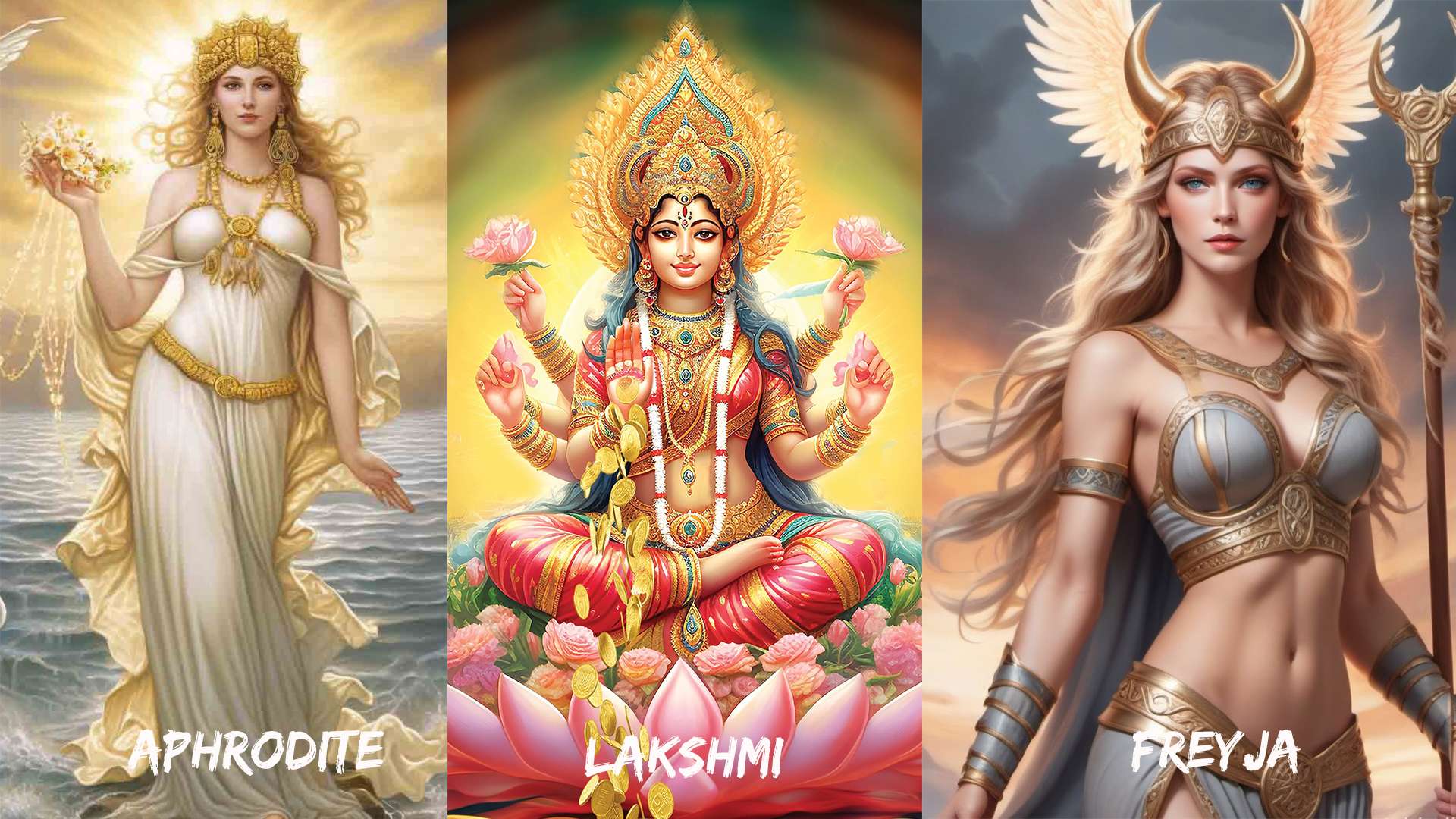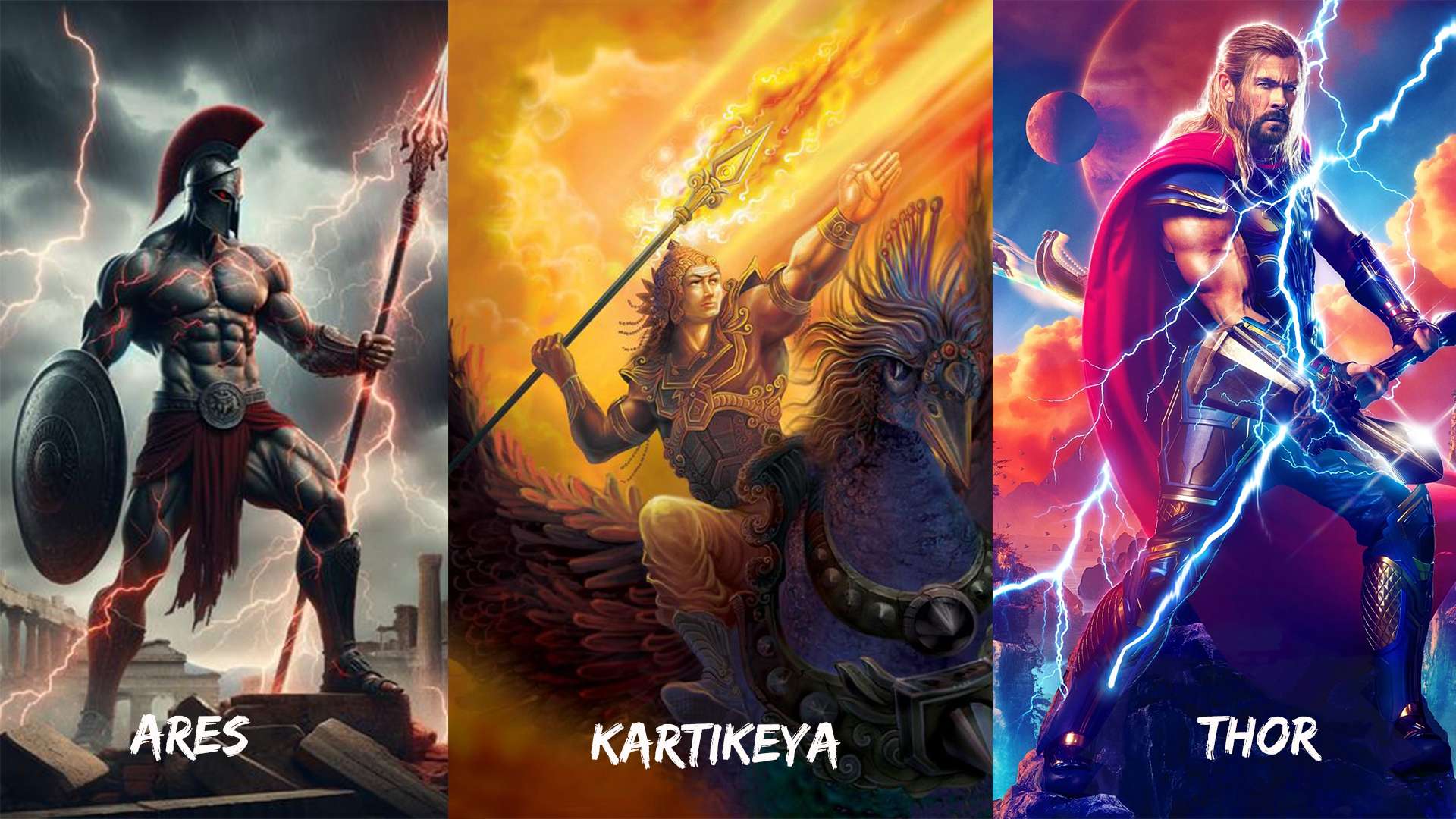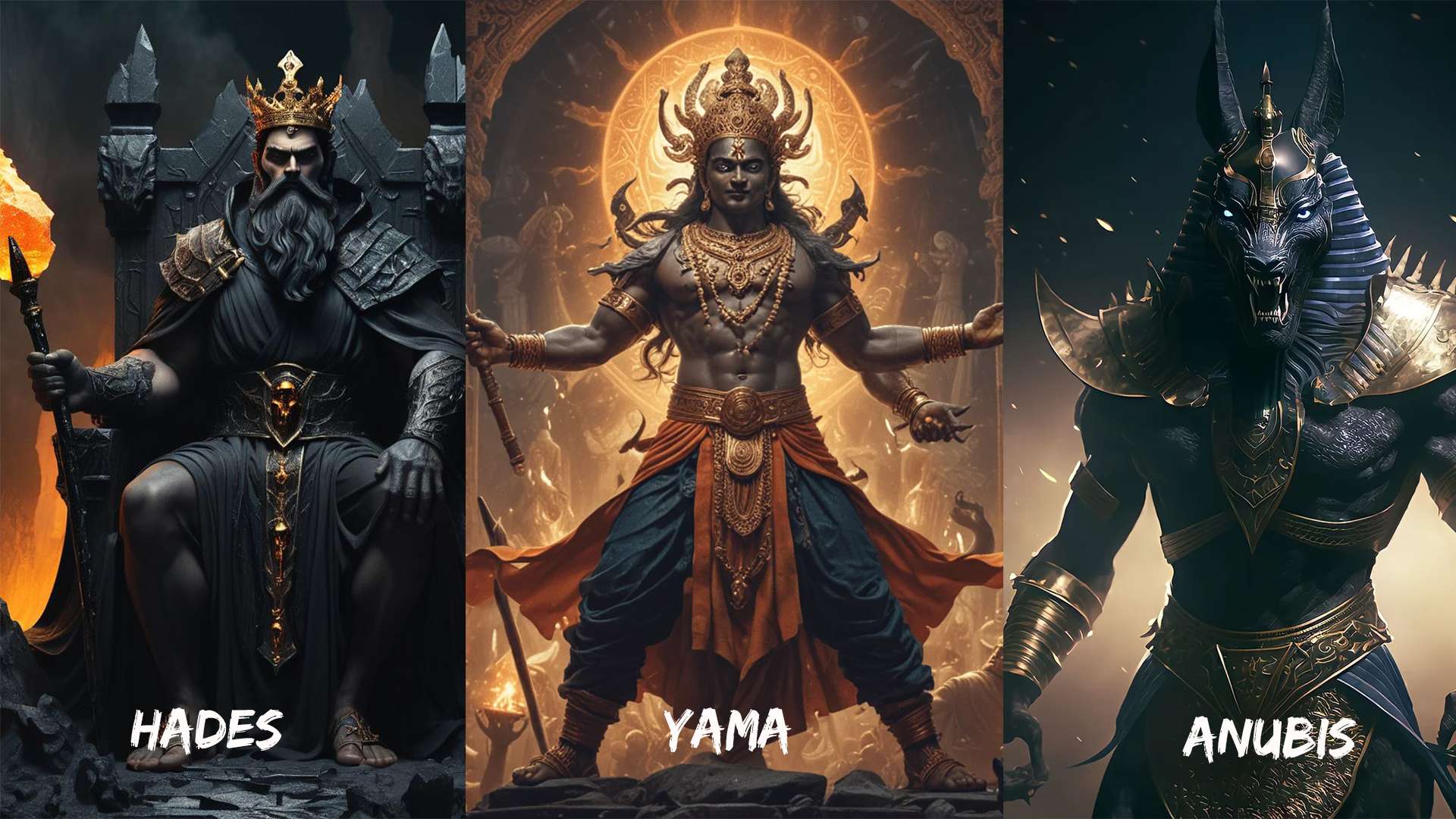Table of Contents
Gods with the Same Interests in Different Mythologies
Mythologies around the world may vary greatly in their settings, stories, and characters, yet they often share common themes. Among these recurring themes are gods who embody similar domains, functions, or interests, reflecting a shared human experience across time and geography. Whether it’s the ruler of the heavens, the god of war, or the protector of love and beauty, these deities highlight humanity’s universal concerns and aspirations.
This blog will explore gods from different mythologies who share similar interests, showing the striking parallels between ancient cultures from Greece, Rome, India, Norse, and Egypt, among others.

1. The Supreme God: Zeus (Greek) vs. Indra (Hindu) vs. Odin (Norse)
Zeus (Greek )
Zeus, the king of the Olympian gods, is the ruler of the sky and thunder. Known for his mighty power, justice, and occasional wrath, Zeus maintains the balance of the cosmos. He is often depicted wielding a thunderbolt and sitting on a grand throne, overseeing the affairs of gods and humans alike.
Indra (Hindu )
Indra, the king of the Devas (gods) in Hindu mythology, also rules the heavens and controls storms, rain, and lightning. Like Zeus, Indra is known for his power, but he also has a deeper connection to war and the protection of the Earth. His thunderbolt, Vajra, is a symbol of indomitable power, making him a fearsome figure in battle.
Odin (Norse)
Odin, the Allfather in Norse mythology, shares characteristics with both Zeus and Indra. He rules the realm of Asgard and is the god of wisdom, war, and death. While Odin lacks direct control over thunder, like Zeus and Indra, his role as the king of the gods and his connection to the afterlife make him a figure of immense authority and influence.
Despite their cultural differences, Zeus, Indra, and Odin serve similar roles as leaders of their pantheons, controlling the forces of nature and maintaining cosmic order.
2. God of the Sun: Apollo (Greek) vs. Surya (Hindu) vs. Ra (Egyptian)

Apollo (Greek )
Apollo is the god of the sun, music, healing, and prophecy. Often depicted driving a chariot across the sky, Apollo represents the life-giving and destructive power of the sun. He embodies both physical light and the metaphorical light of knowledge and enlightenment.
Surya (Hindu)
Surya is the Hindu god of the sun and is considered a provider of life and energy to the universe. Depicted riding a chariot pulled by seven horses (symbolizing the seven days of the week), Surya is worshipped as a symbol of health, vitality, and longevity.
Ra (Egyptian)
Ra, the ancient Egyptian sun god, is one of the most important deities in the Egyptian pantheon. Ra was believed to travel through the sky in his solar boat by day, providing light and warmth, and pass through the underworld by night. His connection to the cycle of life, death, and rebirth made him central to Egyptian cosmology.
The sun gods Apollo, Surya, and Ra are united by their control over the life-sustaining power of the sun, embodying the fundamental human reliance on sunlight for survival, growth, and enlightenment.
3. God of Love and Beauty: Aphrodite (Greek) vs. Lakshmi (Hindu) vs. Freyja (Norse)

Aphrodite (Greek)
Aphrodite, the Greek goddess of love, beauty, and desire, is a powerful figure who influences both the hearts of mortals and gods. Her power is not only linked to physical beauty but also the emotional aspects of love, passion, and fertility.
Lakshmi (Hindu Mythology)
Lakshmi, the Hindu goddess of wealth, prosperity, and beauty, is often depicted seated on a lotus flower, radiating divine grace and charm. Although her primary domain is wealth and fortune, Lakshmi is also associated with love and is worshipped as a provider of happiness and harmony in relationships.
Freyja (Norse Mythology)
Freyja, the Norse goddess of love, beauty, and fertility, shares similarities with both Aphrodite and Lakshmi. She rules over aspects of passion, fertility, and sexuality, but is also a warrior goddess with a connection to death and the afterlife, as she receives half of the slain warriors in battle.
Aphrodite, Lakshmi, and Freyja represent the divine embodiment of beauty, love, and desire across different cultures. While each goddess has her own unique traits, their shared association with love and beauty reflects the universal human yearning for connection and prosperity.
4. God of War: Ares (Greek) vs. Kartikeya (Hindu) vs. Thor (Norse)

Ares (Greek Mythology)
Ares, the Greek god of war, is the embodiment of the violent and chaotic aspects of battle. Unlike other war gods who focus on strategy and honor, Ares thrives on the brutal and destructive nature of conflict, making him a feared and often unpopular figure among both gods and humans.
Kartikeya (Hindu Mythology)
Kartikeya, also known as Skanda or Murugan, is the Hindu god of war and the commander of the celestial army. As the son of Shiva and Parvati, Kartikeya is a master strategist and is known for his valor, bravery, and protective nature, defending the world from demons and evil forces.
Thor (Norse Mythology)
Thor, the Norse god of thunder and war, is a protector of gods and humans alike. Armed with his mighty hammer, Mjölnir, Thor defends Asgard and Midgard from the forces of chaos, including giants and monsters. He is a heroic figure, symbolizing strength, courage, and the fight against evil.
Ares, Kartikeya, and Thor share a common interest in war, but their roles differ in tone. While Ares is associated with the chaos of battle, Kartikeya and Thor represent protection and strategic warfare, embodying the heroism and necessity of defense.
5. God of Death and the Afterlife: Hades (Greek) vs. Yama (Hindu) vs. Anubis (Egyptian)
Hades (Greek Mythology)
Hades, the Greek god of the underworld, governs the realm of the dead. While often misunderstood as a malevolent figure, Hades’ role is to maintain balance in the afterlife and ensure that souls receive their just rewards or punishments. He rules over the dead with a stern but fair hand.
Yama (Hindu Mythology)
Yama, the Hindu god of death and the ruler of the underworld, oversees the transition of souls from the earthly realm to the afterlife. Yama judges the deeds of individuals during their lifetimes and determines their fate, whether it be reincarnation or liberation (moksha).
Anubis (Egyptian Mythology)
Anubis, the Egyptian god of mummification and the afterlife, is responsible for guiding souls through the underworld. Anubis oversees the weighing of the heart ceremony, where the soul’s worthiness for the afterlife is judged. He plays a crucial role in the journey of the soul to its final resting place.
Hades, Yama, and Anubis serve similar functions in different cultures, ruling over the dead and guiding souls to their eternal destinations. Their roles highlight the inevitability of death and the importance of morality and justice in the afterlife.

A Shared Human Experience
The gods of different mythologies may come from diverse cultures and traditions, but they often embody the same basic human concerns: the cycle of life and death, the power of nature, the pursuit of love and beauty, and the need for protection and justice. By comparing these gods across mythologies, we gain a deeper understanding of how ancient civilizations viewed the world and the divine, and how these timeless stories continue to resonate with us today.
